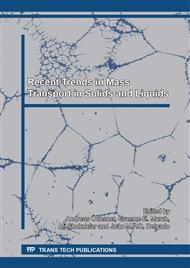p.115
p.120
p.124
p.135
p.141
p.151
p.161
p.167
p.173
The Influence of Temperature and Alloy Composition on Austenitic Stainless Steel Oxidation Resistance
Abstract:
Stainless steels can form a protective oxide layer when exposed to a high temperature oxidising environment, this protective layer forms a diffusion barrier and slows the oxidation of the alloys in harsh environments. This characteristic has made stainless steels one of the most commonly used alloys for high temperature industrial applications. In this work, a systematic testing procedure has been used to investigate the high temperature oxidation of two commonly used grades of stainless steel, 316 and 310. Samples of each alloy have undergone isothermal testing in air at 1050°C, 1150°C and 1250°C for a range of time periods up to 8h. The oxidation kinetics were also investigated using thermo-gravimetric analysis in air at the same temperatures for 8h. The oxide layers formed on the samples were characterised using X-Ray diffraction, Scanning electron microscopy and energy dispersive spectroscopy. Information derived from oxide layer characterisation was used to explain any differences between the two alloys in terms of oxidation rate and overall alloy performance in the high temperature environment.
Info:
Periodical:
Pages:
141-150
Citation:
Online since:
November 2017
Authors:
Price:
Сopyright:
© 2017 Trans Tech Publications Ltd. All Rights Reserved
Share:
Citation:


